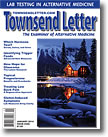|
Page 1, 2, 3
Predictive biomarkers are a few tests that can now be referenced to goal values whose interpretation can include a lifestyle action plan that enhances functional cost and outcome effectiveness, adding years to life and life to years.
This article addresses:
- what these predictive biomarkers are and why they are valid;
- interpretation of the test results based on goal values;
- how to reduce risk and bring tests value to or nearer to the safer value at least cost and best outcome effectiveness.
The existence of predictive biomarkers is the first conceptual advancement in lab medicine since sensitivity, specificity, and predictive index were introduced a generation ago. Integrative, comprehensive, personalized medicine seeks evidence-based objective predictive biomarkers to determine that both risk and response to therapy can be quantified. Each predictive biomarker is selected for its sensitivity; that is, its accuracy, and its specificity; that is, its lack of false results so that its clinical predictive significance – the product of sensitivity and specificity – is high.
Eight predictive biomarkers are proposed here along with their goal values, including which aspect of the metabolome and the microbiome are most affected, and the genes and epigenetic modulation of genetic expression. Strategies and tactics are presented to enable people to improve upon their biomarker values through virtuous cycles and health-enhancing habits of daily living.
Predictive Biomarkers
Predictive markers are independent and interdependent assessments of health risk and status. Together they cover the 92% of lifetime health that is based on lifestyle habits, or epigenetics, if you prefer. While 8% is genetic, over 9/10 of the quality and quantity of life is determined by the sum of what, how, and when people eat, drink, think, and do.
Predictive biomarker test results provide a comprehensive, accessible, actionable, and personalized plan for health with added value when the goal value and interpretation referenced here are included. Eight functional tests, each predictive of outcome, are useful in monitoring therapeutic responses to any program designed the help the person or evoke healing responses.
Usual (Statistical) Test Results vs. Predictive (Healthy) Goal Value Results
Prior to predictive biomarkers, conventional clinical lab tests provided information about "usual" or "normal" statistical ranges of a particular item analyzed. They are useful for population studies but not clinically as relevant or predictive. By contrast, these specific predictive biomarker tests provide information that extends the concept of "optimum," or "high-level health," reference ranges pioneered by Cheraskin and Ringsdorf or the biochemical individuality concept documented by Roger Williams.1-3 The goal values recommended here for each predictive biomarker are designed to improve predictive personal precision in practice and are set to be the least risk or highest gain value for each test. When predictive biomarker tests are at their goal value, all-cause morbidity and mortality are at their best outcome value; quality of life and lifespan are optimized. The specific predictive biomarker tests included have each also been validated on large numbers of people from all ethnic and socioeconomic backgrounds.
Predictive biomarkers referenced to goal values and interpreted with a focus on epigenetic opportunities and lifestyle habit changes can stimulate virtuous behavior cycles, and more cost-effective and outcome-effective care for each individual.
Table 1 gives an overview of the predictive biomarkers here suggested with their clinical significance.
| Predictive Biomarker Test |
Metabolome, Microbiome, Genes, & Epigenetics |
| Hemoglobin A1c (Hgb A1c) |
Sugar, energy, diabetic risk & insulin resistance; epigenetic metabolic syndrome; syndrome X |
| High sensitivity C-reactive protein (hs-CRP) |
Epigenetic inflammation, repair ability; calls for immune help; telomere length |
| Homocysteine |
Epigenetic methylation, detox, transport, sulfur cycles |
| Oxidized LDL/HDL |
Epigenetic CVD risk; lipid AO status |
| 8-oxoguanine |
DNA oxidative stress; nuclear AO status |
| Vitamin D |
Epigenetic cell talk & adhesion, C, CVD, & AI risks |
| 1st morning (a.m.) urine pH |
Metabolic acidosis; mineral status; cell battery |
| LRA by ELISA/ACT |
Immune tolerance or intolerance; delayed allergies |
Legend: AI: autoimmune; AO: antioxidant; C: cancer; CVD: cardiovascular diseases; DNA: genetic code; deoxyribonucleic acid; ELISA/ACT: enzyme-linked immunosorbent assay/advanced cell technique; LRA: lymphocyte response assay
Predictive Biomarker 1: Glycosylated Hemoglobin/Hemoglobin A1c (Hgb A1c)
Hemoglobin A1c (Hgb A1c) most accurately measures average glucose or blood sugar. Fasting and 2-hour postprandial blood sugar have long been measured to get information about moments in time. More recently, insulin and glucose/insulin ratios have been developed to better understand sugar energy metabolism. Hgb A1c better predicts average blood sugar level for the previous 3 months than any other lab test.
This is important because frequently people have unremarkable blood sugar on the particular day that the test is run, but their Hgb A1c is elevated, or conversely stress may increase blood sugar at a moment while Hgb A1c is low, showing that "white coat" blood sugar elevations happen just as do blood pressure elevations. Day-to-day blood sugar levels can be distorted by many pre- and postanalytic variables such as exercise, meal timings, or medications. More importantly, we do not see high blood glucose levels routinely until prediabetes is far advanced. Hgb A1c gives more reliable indication of actual and future risk.4 Accurate fasting blood sugar values require at least 12 hours of water only prior to the blood draw. In practice, this preanalytic variable is often ignored.
Hgb A1c is a marker of insulin sensitivity and resistance. Elevated Hgb A1c is strongly linked to inflammation as well as chronic, degenerative, autoimmune disease risks.
A Hgb A1c of <5% is the desired or goal value and reflects a 99% probability of living 10 years. The graphs below (Figures 1A and 1B) represent the correlation between Hgb A1c levels, blood glucose levels, and 10-year survival probability.
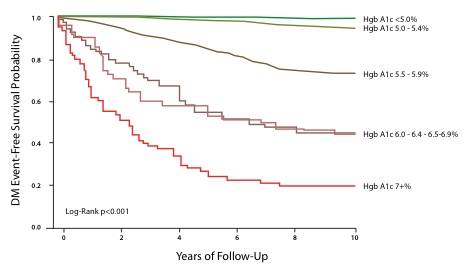
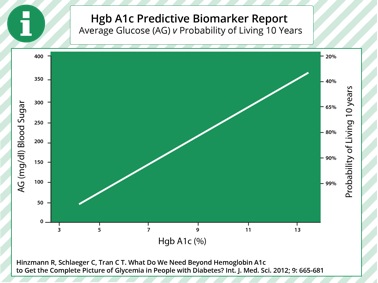
When above goal value, an immunotolerant diet of whole foods enriched with super-foods and targeted full disclosure supplements directed to improve energy, glucose, and insulin balance, is included as part of the interpretation. Being active physically and mentally is also included in the recommendations designed to evoke healing responses.
Predictive Biomarker 2: High-Sensitivity C-Reactive Protein (hs-CRP)
High-sensitivity C-reactive protein (hs-CRP) is one of the most predictive markers of inflammation systemically and particularly in the cardiovascular system. Levels of hs-CRP rise in response to repair need, also known as inflammation. Hs-CRP is more precise and predictive at low levels than CRP.5
When inflammatory repair deficit persists, often a chronic damaging process is slowly smoldering below the surface that is merely troublesome and not yet disabling progresses. Inflammation burdens the body's organ systems, especially the immune system, slowly wearing it down, taking a toll on daily quality of life, increasing risk, and reducing survival.6
The charts below (Figures 2A and 2B) represent the correlation between hs-CRP, Framingham 10-year CVD risk scores, and 10-year survival probability. Elevated hs-CRP is common in prediabetes and diabetes, reflecting insulin resistance and metabolic syndrome X, a continuum of conditions with increased inflammation and a high risk of cardiovascular complications due to cumulative repair deficits. Elevated hs-CRP levels may indicate a long-term chronic infection or host hospitality due to cumulative repair deficit;that is, inflammation.
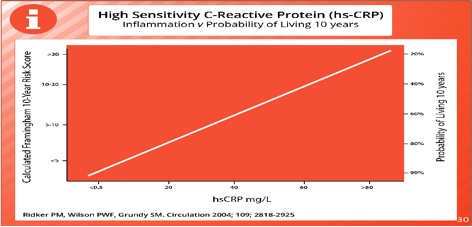
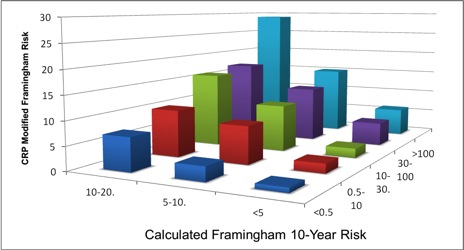
As a predictive biomarker, hs-CRP reflects the effectiveness and efficiency of first line innate cellular immune defenses, responsible for neutralizing any sign of infection, repairing daily wear and tear, and identifying and eliminating cancerous cells.
Hs-CRP goal value is <0.5 mg/dl.
If hs-CRP is above goal value, our interpretation includes an immunocompetent diet of whole foods with an emphasis on repair-promoting super-foods, targeted supplementation directed toward adequate systemic repair, as well as mental and physical activities to evoke healing responses.
Predictive Biomarker 3: Homocysteine
Homocysteine is an amino acid whose balance with methionine reflects methylation status. Methylation controls many aspect of cell function, including expression of our genetic material; modulates RNA; and helps transport or deposit proteins. When this process is not working properly, homocysteine levels are elevated. Homocysteine reflects a deeper imbalance in two critical important aspects of metabolism, detoxification and methylation within all cells.
Page 1, 2, 3
|
![]()
![]()
![]()




